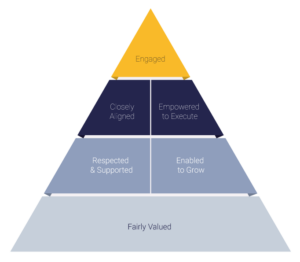Every company has a culture, good or bad. In today’s environment, smart leaders know that a healthy, engaged workplace culture can be a competitive advantage that competitors cannot copy. After all, employee engagement is the best way to limit unwanted turnover, boost productivity, and increase referral rates.
Employee engagement is the outcome of a healthy work environment. It’s also the most tangible measure of culture. Improving company culture takes intentional effort, but over time, it becomes self-sustaining and attracts like-minded people who are more likely to be engaged and thrive in the environment.
Learn More: What Makes a Great Place to Work and The Top 9 Qualities of a Great Workplace
What employee engagement is
Energage defines employee engagement as “a positive psychological state where an employee feels an emotional commitment to the organization and its goals.” It goes beyond job satisfaction, encompassing motivation, commitment, and referral. Engaged employees demonstrate positive attitudes, influencing satisfaction and retention. In contrast, disengagement leads to turnover, decreased productivity, and potential damage to a company’s employer brand.
Why employee engagement matters
From retention and referrals to motivation and productivity, employee engagement can be a game-changer. That’s why more and more organizations are investing their time and resources into it.
Employee engagement is vital for both employees and employers. It gives employees a sense of purpose and connection, driving their passion and dedication to their work. Engaged employees thrive and contribute to the organization’s mission.
Employee engagement is crucial for employers because it cultivates passionate advocates who strive to achieve company goals. It also plays a significant role in reputation management. When companies align their decisions with their mission, vision, and values, employees become engaged, resulting in higher job satisfaction, retention, and optimal performance.
Learn More: What Is Employee Engagement and Why Is It Important?
What drives employee engagement
Some people believe you can improve employee engagement with fancy perks, but the truth is that many workplace experience themes drive employee engagement, including employees who feel:
- Fairly Valued
- Respected & Supported
- Enabled to Grow
- Closely Aligned
- Empowered to Execute

Visualize workplace experience themes as a hierarchical pyramid. Low scores at the bottom level pose challenges in influencing the higher levels.
The foundation of the pyramid represents the individual employee experience. The next level embodies the employee-manager relationship, while the third level encompasses areas influenced by senior leadership.
By comprehending your organization’s scores in each theme, you can strategically direct improvement actions to impact your workplace culture.
Recognizing that different levels of the pyramid can be effectively influenced at different organizational levels, the Workplace Themes also guide the involvement of relevant stakeholders in these actions.
20 key drivers of employee engagement
1. Company values
When setting the tone for your organization’s culture, company values pack a serious punch. In a constantly changing world, these values are the glue that keeps your workplace together. Strong values propel your company forward, while weak ones can damper success.
Top Workplaces research shows that employees who truly embrace and live by the company values are more likely to be super engaged. That means they’re ready to bring their A-game to work each day, giving it their all to pursue greatness.
2. Meaningfulness
Since folks spend a big chunk of their waking hours on the job, it’s no wonder they crave truly meaningful work. When people find purpose in what they do and the people they serve, it’s a game-changer. They become charged with productivity, commitment, happiness, and engagement. It’s not just about collecting a paycheck or enjoying perks anymore — it’s about finding a deeper connection and leaving a lasting impact.
3. Direction
Top Workplaces are made up of employees who believe in the direction set by senior leadership. But getting direction right can be challenging. That’s because it requires a smart strategy and regular communication. When done right, employees who believe in the direction of your organization will invest more of themselves in their work because they know it will make a difference.
4. Employee appreciation
Appreciation consistently ranks as one of the strongest drivers of employee engagement. It’s also one of the simplest and least expensive ways to impact morale, productivity, and retention. Who and what you celebrate says volumes about the type of culture you’ve got going on — and the culture you want to cultivate.
When genuine appreciation becomes a daily habit, you create a culture that people want to be part of and motivates them to contribute in every way. Employee appreciation is like a secret sauce that makes your workplace irresistible.
Learn More: 9 Employee Recognition Award Ideas
Learn More: Importance & Benefits of Employee Recognition
5. Concerns
When managers genuinely care about their employees, something remarkable unfolds. They cultivate trust and mutual respect, creating a safe haven where employees feel encouraged to innovate and take ownership of their work. This benefits the individual employee and their manager and sets the stage for the entire organization to thrive. Together, they form an unstoppable force capable of achieving remarkable things and tapping into their fullest potential.
6. Inclusion
Research shows that diverse, inclusive organizations outperform the competition in profits, cash flow, revenue, and more. In addition, teams at these companies exhibit better (and faster) decision making, increased collaboration, and stronger commitment.
Inclusion requires more than building a diverse workforce. To succeed, you must create a genuinely open culture respecting individual differences — where people feel safe bringing their best selves to work daily. An inclusive workplace means people have equal opportunities to contribute ideas and feel a sense of belonging, increasing their commitment to the organization and its goals. In short, when employees feel included, they become more engaged.
Learn More: Promoting DEI in the Workplace
7. Innovation
Successful companies strive for continuous improvement. But don’t expect the few people at the top to be responsible for all new thinking. After all, it’s generally the people closest to the problem — and the customer — who are closest to the best solution.
Encouraging new ideas throughout the organization benefits company performance and helps employees reach their full potential. It also strengthens culture by increasing trust and buy-in. And when employees are empowered this way, they feel safe to take the calculated risks needed to chase continuous improvement.
8. Open-mindedness
If you want to enable better decision making, improve problem solving, and power innovative thinking, your culture must welcome input from all sources. Open-mindedness is the difference between employees that follow orders and a culture that actively encourages debate and fresh perspectives. And when you have many people and perspectives united toward one mission, the real magic happens.
9. Training
Training provides the tools needed for employees to perform their current jobs and grow into future ones. New hires and longer-tenured employees desire growth and may seek it elsewhere if the organization needs to provide it. Training also ensures strong organizational execution and minimizes the risk of errors, including costly and dangerous ones related to safety, technology, and more.
Learn More: A Guide to Employee Training & Development Programs
10. Potential
Potential is a huge motivator for most employees. That’s why it’s unsurprising that it’s closely tied to engagement. Employees who can’t work at their full potential may feel stuck or unrecognized, making them more likely to start a job search. But when people can reach their full potential, so will your organization.
11. Development
Continued learning and professional development are other important drivers of employee engagement. They make employees feel supported and encouraged but can also help individuals do their job better. Everyone within the company should have access to professional development tools, and leaders must encourage employees to take advantage of those tools. Opportunities for learning and growth make individuals feel valued and appreciated.
Learn More: Benefits of Training & Development
12. Clued-in employees
When employees feel included in important decisions, they feel like a true partner — and more connected as a result. They’re also more likely to align with your organization when change occurs, even if they disagree with the methods.
Communicating important decisions effectively throughout the organization lays the groundwork for successful change and growth. Done right, you’ll notice that employees are more receptive to modifications in the workplace. This is especially true if the changes were inspired by employee feedback.
13. Clued-in leaders
Employees need to know that senior leaders know what the day-to-day looks like. That’s what being a clued-in leader is all about. And when senior leaders genuinely understand, they’re better equipped to serve the market. At its core, it’s about employees feeling heard and senior leaders acting on what they hear. When senior leaders appear out of the loop, it’s difficult for employees to connect with the company’s mission and strategy. And when this happens, it also means senior leaders are missing out on valuable insights from those closest to customers.
14. Execution
Inefficiency is a significant cause of poor performance for individuals, teams — and the organization. Inefficient processes and procedures are a big source of frustration for employees, especially when they cannot address them.
An efficient organization makes good use of its investments, increasing revenue with less expense. And when people feel like part of a winning team, they feel empowered to do what needs to be done to support the company’s mission.
15. Cooperation
The best organizations are greater than the sum of their parts. When everybody in the organization works toward a common goal, each team becomes more effective. And when teams work well together, employees feel a sense of belonging.
Implementing a successful strategy is only possible with interdepartmental cooperation. Teams that strain against each other create unnecessary friction, and these types of culture fractures introduce challenges for employee morale, job satisfaction, and performance.
16. Meetings
Recent research suggests that some people spend up to a third of the workweek in meetings. And for a good reason — meetings are where decisions are made, collaboration happens, and relationships are built.
But everyone can agree that poorly run meetings are a waste of time, not to mention their cost on day-to-day work. That’s why it’s essential to include the right people, cover the right topics, and address them correctly.
17. Benefits
A well-rounded benefits package conveys your commitment to the overall well-being of your employees, extending beyond the confines of the workplace. As today’s workforce comprises multiple generations, it becomes essential to curate a benefits offering that caters to each individual and generation’s diverse needs and preferences. When employees’ expectations align with the benefits received, and they perceive fair treatment for their efforts, their engagement levels are more likely to increase.
Learn more: Employee Perks and Benefits
18. Expectations
Setting realistic expectations with new hires is critical to ensuring a positive experience. Whatever your basic employee value proposition is, failing to deliver on it will be painful. But when expectations are met, the topic won’t often come up.
Expectations can be a key predictor of employee turnover, especially for employees who have been with your organization for fewer than five years. That’s why it’s essential to know where you stand and communicate that clearly as part of the hiring process. Then, continue to meet the expectations you set.
19. Pay
Often, top talent looks for organizations with pay transparency efforts in place. Fair compensation and honest conversations about the topic contribute to employees feeling valued and appreciated. It also establishes a foundation of mutual trust and positive working relationships. When employees and employers are aligned in their understanding and agreement regarding compensation fairness, it contributes to the success and prosperity of the organization as a whole.
20. Work-life flexibility
Work-life flexibility is more important than ever. Companies that encourage it are more appealing because it shows that leadership prioritizes its employees’ mental and physical health. A flexible workplace means it places more importance on the quality and completion of work and less on where and exactly when the work gets done.
Work-life balance leads to engaged employees who work harder, increasing productivity and profitability. Plus, prioritizing that balance and employee well-being boosts retention.
Employee engagement leads to these three outcomes
While employee engagement is valuable to track, business metrics show how improving the employee experience can improve financial performance. These provide an approximation of business outcomes that can be measured and benchmarked against all industries:
- Motivation: Employees bring their best to work each day.
- Referral: Employees are willing to recommend the company to others.
- Loyalty: Employees are not looking for new opportunities.
Identifying drivers of employee engagement in your organization
While several common drivers of employee engagement exist, knowing which ones matter most to your employees is essential. One of the most effective ways to measure employee engagement is to capture feedback through an employee engagement survey. A credible, research-backed survey such as the one used to identify the nation’s Top Workplaces provides accurate data and insights.
In addition to surveying your employees, it’s essential to show them they’ve been heard. Discuss the action steps you plan to take with them because of the feedback they provided. This two-way communication will increase trust, a sense of purpose, appreciation, and engagement.
Learn what motivates your employees with Top Workplaces
Employee engagement may differ from one company to the next — and even from one team to the next. Companies that understand the value and purpose of capturing employee feedback through employee engagement surveys can better drive employee engagement.
Participating in Top Workplaces awards is one way of showing job seekers your company values a people-first culture. It can also improve your recruiting efforts, attract talent, and retain your best people.
Identify the key drivers of engagement for your employees. Nominate your organization for Top Workplaces, the employer recognition program that offers awards in 60+ regional markets and national awards for culture and industry excellence.

